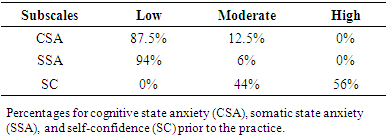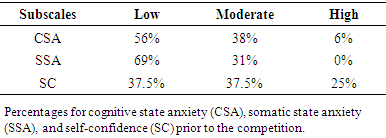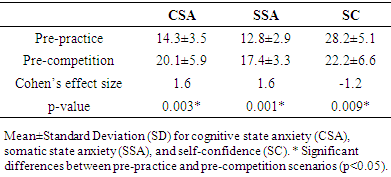-
Paper Information
- Previous Paper
- Paper Submission
-
Journal Information
- About This Journal
- Editorial Board
- Current Issue
- Archive
- Author Guidelines
- Contact Us
International Journal of Sports Science
p-ISSN: 2169-8759 e-ISSN: 2169-8791
2021; 11(2): 39-45
doi:10.5923/j.sports.20211102.03
Received: Aug. 16, 2021; Accepted: Aug. 28, 2021; Published: Sep. 15, 2021

Examination of Anxiety Levels: Practice vs. Competition among High School Track and Field Athletes
Sarah Hurst, Abigail Larson, Mark DeBeliso
Department of Kinesiology and Outdoor Recreation, Southern Utah University, Cedar City, UT, USA
Correspondence to: Mark DeBeliso, Department of Kinesiology and Outdoor Recreation, Southern Utah University, Cedar City, UT, USA.
| Email: |  |
Copyright © 2021 The Author(s). Published by Scientific & Academic Publishing.
This work is licensed under the Creative Commons Attribution International License (CC BY).
http://creativecommons.org/licenses/by/4.0/

Somatic and cognitive state anxiety levels can increase before a competitive event which can result in decreased performance and increase injury risk. Identifying situations that could cause high levels of anxiety are important so that proper anxiety management techniques can be implemented. PURPOSE: The purpose of this study was to compare levels of somatic and cognitive anxiety as well as self-confidence among high school track and field athletes prior to practice and competition. METHODS: One high school track and field team (n=16: male n=8, female n=8) completed the Competitive State Anxiety Inventory-2 (CSAI-2) survey prior to competition and again prior to practice. The CSAI-2 contains three subscales (cognitive anxiety, somatic anxiety, and self-confidence). The CSAI-2 subscale scores were compared between the pre-practice and the pre-competition scenarios with paired t-tests (α<0.05). RESULTS: Statistical differences in the subscale scores (cognitive anxiety, somatic anxiety, and self-confidence) were found between practice and the competition (p<0.05). CONCLUSIONS: Within the parameters of this study, anxiety appears to be higher and self- confidence lower prior to a competition versus practice. Future research should examine if such a relationship exists among other high school sports.
Keywords: CSAI-2, Adolescent anxiety, Track and field, Performance anxiety, Pre-practice, Pre-competition
Cite this paper: Sarah Hurst, Abigail Larson, Mark DeBeliso, Examination of Anxiety Levels: Practice vs. Competition among High School Track and Field Athletes, International Journal of Sports Science, Vol. 11 No. 2, 2021, pp. 39-45. doi: 10.5923/j.sports.20211102.03.
1. Introduction
- Anxiety is a factor that almost every athlete will have to deal with in their career, whether they are novice or elite. The prevalence of anxiety makes this psychological stressor a significant concern for athletes and coaches [11]. High levels of anxiety can be detrimental to performance therefore identifying situations that induce an exaggerated anxiety response is essential in order to help the athlete control anxiety levels and achieve a flow state [21]. Successful performance can be attributed to controlling emotions during a competition for both coaches and athletes [15]. Anxiety can be thought of as harming the mental focus and thus adversely affecting performance [25]. Anxiety, as defined by Williams [26], is an irrational response to a threat, either perceived or real, that causes both a physical and psychological response to the body, which includes: excessive worry, autonomic arousal, difficulty breathing, dizziness, muscle tension, and a varying level of fear, all of which can cause an impairment in performance [26].Importantly, anxiety is multidimensional in nature and can be divided into cognitive state anxiety (CSA) and somatic anxiety (SSA) [26]. An athlete can exhibit either or both forms of anxiety [19]. Cognitive anxiety is generally characterized by negative thoughts, including but not limited to negative expectations, low self-esteem, concerns about one’s abilities, and failure [27]. Negative thought processes can result in apprehension with competitions and interfere with concentration, leading to motor movement changes [27]. Somatic anxiety is characterized by physical autonomic arousal or the fight or flight response which includes increased heart rate, increased blood pressure, a rise of cortisol levels, increased muscle tension, increased sweating, and dry mouth [15,26]. Self-confidence (SC) is related to anxiety and is defined as one’s belief in meeting the task’s performance challenge [5,25]. Higher SC levels are essential to combat anxiety during a performance that an athlete deems crucial [5].
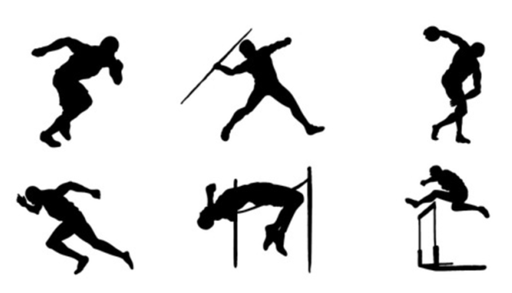 | Figure 1. Track and Field (courtesy of <a href="https://icon-library.net/icon/track-and-field-icon-1.html">Track And Field Icon #204541) |
2. Methods
- ParticipantsThe participants in this study were high school track and field athletes participating on the Bear River High School track and field team (Utah, US). Any athlete that was registered and able to compete with the high school track and field team was permitted to participate in this study. The athletes ranged in age from 15 to 18 years old (n=16: male n=8, female n=8). The study was conducted during the traditional spring season.After IRB approval (SUU IRB approval # 21-022021c), participants and their guardians were given a written informed consent form that explained the study purpose, procedures, and risks. Participants who agreed to participate completed an informed consent/assent form, with their guardians’ signature, prior to filling out the questionnaire. No compensation was provided for participating in the study. InstrumentThe CSAI-2 questionnaire was used for this study. It includes 27 questions that assess state anxiety in the dimensions of CSA, SSA, and SC (self-confidence). Each question was answered using a Likert-like scale that ranges from 1 (not at all) to 4 (very much so). All three subscales were calculated according to Martens, Vealey, and Burton [28]. After each questionnaire was scored, the subscale scores were characterized as follows: 9 to 18 points low levels of anxiety or SC, 19 to 27 points moderate levels of anxiety or SC, and 28 to 36 points high levels of anxiety or SC [4]. The CSAI-2 has demonstrated an internal consistency across subscales of r=0.79-0.94 [10,12] and a test-retest reliability ICC=0.79-0.94 across subscales [16]. ProceduresThe CSAI-2 survey was administered to the same athletes on two separate occasions, once prior to a practice and again prior to a competition. On both occasions, the surveys (CSAI-2) and pens were provided to the track and field athletes. During the first occasion, the track and field athletes completed the CSAI-2 just prior to getting on the bus for the first competition of the season (see Figure 2). After all surveys were completed and collected, the survey scores were entered into an Excel spreadsheet. The scores of the subscales were then classified as previously described.
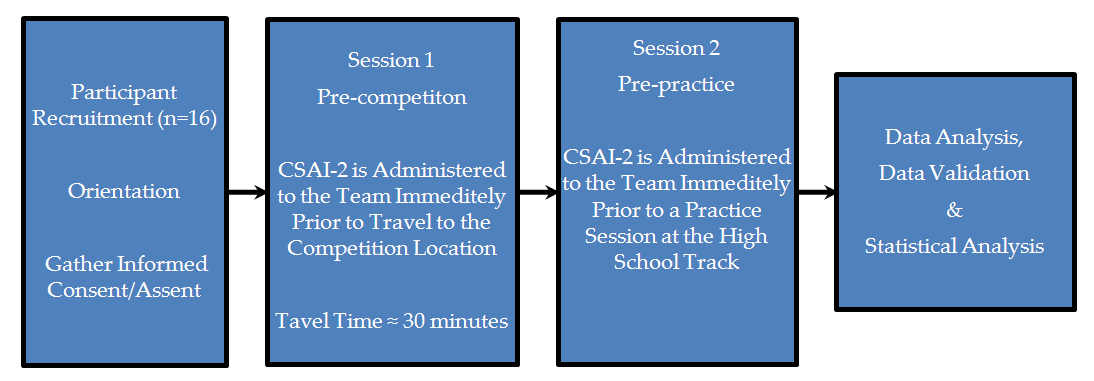 | Figure 2. Study time line of events |
3. Results
- Sixteen male (n=8) and female (n=8) high school track and field athletes completed the study without incident. Table 1 and Table 2 show the number of athletes that demonstrated low, moderate, or high levels of Cognitive State Anxiety (CSA), Somatic State Anxiety (SSA), and Self Confidence (SC) for pre-competition and pre-practice situations, respectively. Visual examination of the frequency distribution of the subscale scores suggested evidence of normality.
|
|
|
4. Discussion
- The aim of the current study was to determine if there was a difference in CSA, SSA, and SC among high school track and field athletes ages 15-18 between pre-practice and pre-competition situations. It was hypothesized that there would be a significant difference in CSA, SSA, and SC between the two environments. Specifically, SC would be higher pre- practice versus pre-competition while CSA and SSA would be lower. The results of the study supported the hypothesis.An individual’s anxiety of an expected negative result has biological and psychological effects when faced with a specific situation [23]. In the current study, between both pre-practice and pre-competition scenarios, there was a significant difference (p<0.01) in anxiety and SC. Before practice, 87.5% (n=14) athletes expressed low CSA levels, 94% (n=15) athletes expressed low SSA levels, and 56% (n=9) athletes expressed high SC levels. Before the competition, 56% (n=9) athletes expressed low CSA levels, 69% (n=11) athletes expressed low SSA levels, and only 25% (n=4) athletes expressed high SC levels. While anxiety is a state that most athletes will deal with at some point in their career, it can have either a negative or positive effect on performance [21]. However, within this study, there was no actual measurement of performance determined. The current study results demonstrated that the level of anxiety rises before a competition are consistent with previous research results [2,17,23,24].In the current study CSA and SSA were found to be highly associated (r=0.86). Further, CSA and SSA were found to be moderately (negative) associated with SC (CSA vs SC: r=-0.58, SSA vs SC: r=-0.40). Athletes with higher anxiety levels reported a lower SC level, suggesting that it may be more difficult for the athlete to combat the higher anxiety levels and impede the ability to obtain optimal performance. The aforementioned relationship between anxiety (CSA and SSA) and SC in the current study is consistent with that reported by Yee et al. [28] (collegiate gymnasts) as well as Reid et al. [16] (adolescent gymnasts).A study of Dutch National female volleyball players examined state anxiety and self-confidence before and after competition using the CSAI-2 questionnaire [23]. CSA and SSA were found to be significantly lower following the competition while SC was found to increase. While the relationship between (i.e. correlations) CSA vs. SSA, CSA vs. SC, and SSA vs. SC were not specifically discussed [23], the significant changes from pre to post competition among the CSAI-2 subscales suggest a similar pattern to those observed in our study; moderate negative relationships between anxiety subscales and SC, and a high positive relationship between CSA and SSA. In the present study, the level of SC diminished before the competition scenario. The level of SC is suggested to impact the effect of anxiety on the athlete [5]. The higher the SC reported the better an athlete is believed to handle higher anxiety levels without detriment to performance [5]. The study [23] also found significantly lower levels of pre-competition SSA among players with ≥12 years of practice. While the authors [23] did not attempt an explanation regarding the reduction in pre-competition SSA based on years played, the authors suggested that mental coping skills and preparedness are important factors that help facilitate success [23]. Given the fewer years of practice among younger athletes, as in the current study, it would seem even more salient to implement anxiety-management techniques for the purpose of enhancing performance.The CSAI-2 questionnaire is a common method utilized to evaluate CSA, SSA, and SC. However, a meta-analysis of 29 studies performed by Craft [4] demonstrated that it might not be the most accurate questionnaire for several reasons [4]. The wording of the CSAI-2 questionnaire could be difficult for some participants to understand and the survey focuses on the symptoms of anxiety versus anxiety as a whole [4]. Additionally, the time frame in which the CSAI-2 is administered relative to the performance task may influence the validity and reliability of the CSAI-2; for example the survey demonstrated greater predictive power when administered to open skilled sports (individual sports with changing environments), like track and field, 31-59 minutes before competition [4]. The predictive power of the CSAI-2, when administered under 30 minutes before the start time of the competition was shown to have less predictive power among wrestlers and golfers [4]. According to Craft et al., the reason was a focus shift off of the questions of the survey to mental preparation of the competition [4]. Regarding the timing of the administration of CSAI-2 questionnaire, a limitation of the current study was assessing participants within the 31- 59 minute window. All athletes were assessed prior to travel to the competition, which caused a variant with respect to the timing between the administration of the CSAI-2 and the event start times (i.e. whether within the 59- minutes or outside the window). Given the aforementioned limitations of the CSAI-2 instrument, the level of significance between (i.e. p-values and effect sizes) the pre-practice and pre-competition subscale scores noted in the current study suggests that there is a real difference in anxiety and SC between the scenarios investigated in the current investigation.For coaches and athletes, self-regulation and attentional situational control are important to help manage anxiety and its effects on performance [15]. The allocation of attention to the situational demand is attentional control. Anxious athletes who lack attentional control concentrate on a threatening stimulus rather than the skills of the task at hand [25]. During a successful performance, an athlete, who has attentional control and the ability to control the stimuli, can meet the demands and perform at their peak performance under pressure and are able to adjust to situational demands [4,11]. A study regarding anxiety control among athletes ages 12-18 years old who participated in various sports showed significant improvements in controlling anxiety with age [8]. The researchers also looked at the correlation between anxiety and motivation, the influence of performance evaluation, and mental ability [8]. Higher levels of motivation, mental ability, and performance evaluation were found to correlate with greater abilities to control anxiety levels [8]. Espada’s [8] study also indicated that individual sport athletes have increased anxiety of performance evaluation and difficulty in anxiety control [8]. As such, implementing a strategy to develop coping skills and mental ability at a younger age appears prudent for young individual sport athletes [8]. A case study performed by Prapavessis [15] evaluated the effect of implementing relaxation, imagery, and self-awareness techniques in a competitive shooter (case study) [15]. The researchers found that the individual levels of SSA and CSA were decreased after self-awareness training [15]. Even though this study was limited as a case study, it was speculated that this type of training maybe beneficial to athletes and coaches that implement imagery and relaxation techniques as potential solutions to mastering anxiety levels. “Butterflies” are part of a competition, but getting them to work for you and not against you is a goal of athletes and coaches [11].The current study had several limitations. The number of participants that completed the study was small. Possible reasons for the limited number of participants could be the non-return of the signed consent/assent forms or the anxiety of participating in a research project. Another limitation is that the CSAI-2 questionnaire is self-reported data, so the assumption was that the participants were honest and understood the questions being asked. With that said, the internal consistency (Cronbach’s α) for the CSA, SSA and SC subscales were 0.78, 0.72, and 0.82 respectively, which is consistent with prior research [10,12,16].The sport of track and field involves many ways to participate: long-distance running, sprinting, jumping, and throwing. The current study did not look at the potential difference in anxiety between runners versus field event athletes or short distance runners (sprinters) versus long distance runners. While athletes can participate in both, the difference could be a potential area to investigate. Also, the years of participation in track and field was not evaluated. Previous studies have examined the importance of years played as a potential benefit towards managing anxiety [2].
5. Conclusions
- Within the parameters of this study, there was a significant difference in CSA, SSA, or SC between pre-practice and pre-competition scenarios among high school track and field athletes. Anxiety and SC change to a less advantageous state prior to a competition scenario. Specifically:• 56% of athletes reported Low CSA pre-competition versus 86% of athletes’ pre-practice. • 69% of athletes reported low SSA pre-competition versus 94% of athletes’ pre-practice. • 25% of athletes reported high SC pre-competition versus 56% of athletes’ pre-practice. Knowledge regarding when an athlete will experience higher/lower anxiety and/or SC levels may inform athletes and coaches when to engage anxiety-management techniques for the purpose of optimizing performance.
 Abstract
Abstract Reference
Reference Full-Text PDF
Full-Text PDF Full-text HTML
Full-text HTML